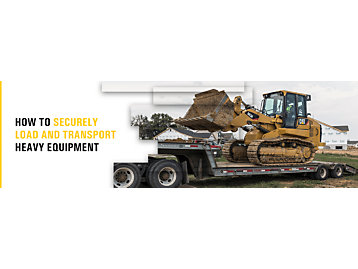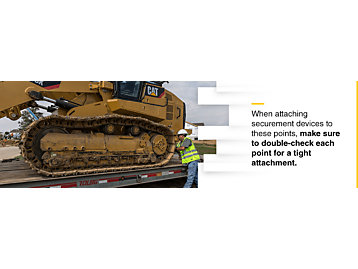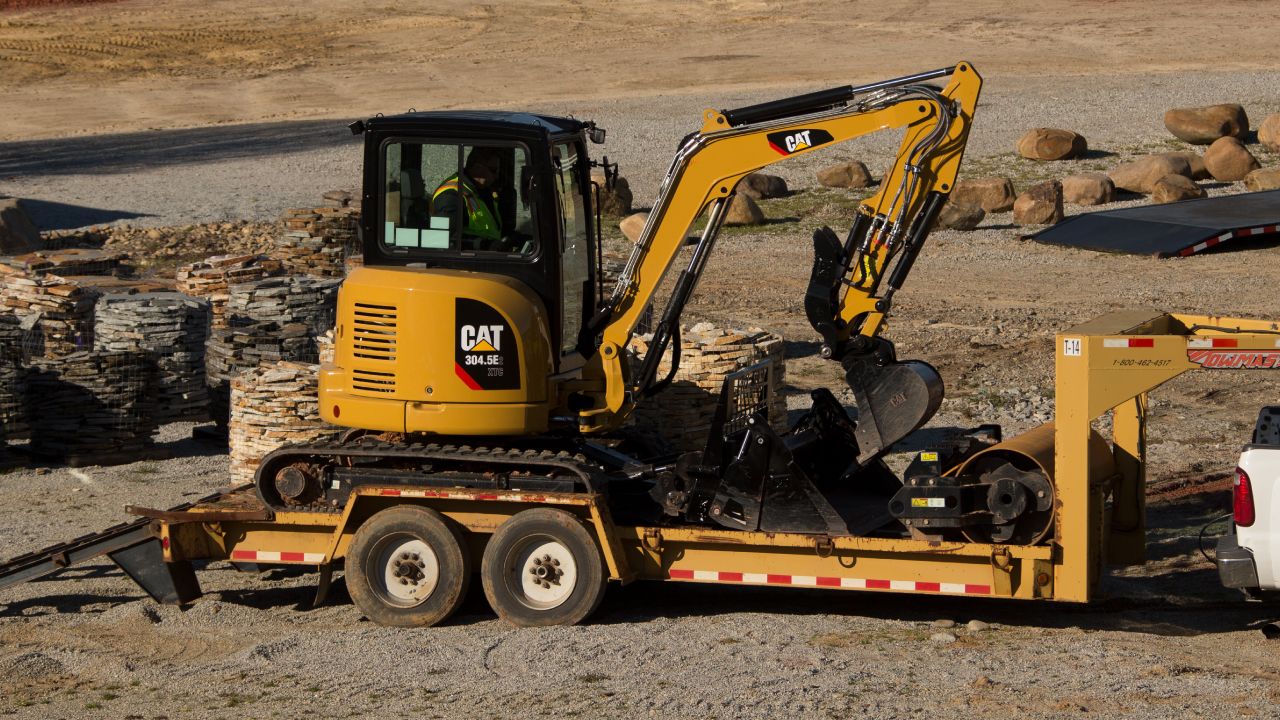

Sign In
Welcome! Sign In to personalize your Cat.com experience
If you already have an existing account with another Cat App, you can use the same account to sign in here
Register Now
One Account. All of Cat.
Your Caterpillar account is the single account you use to log in to select services and applications we offer. Shop for parts and machines online, manage your fleet, go mobile, and more.
Account Information
Site Settings
Security
Author: Small Business Expert | February 6, 2023 | Topic: Used Equipment

Whether you work in construction or landscaping, transporting your equipment to work sites is a big part of the job. Before you take your machine to a new site, you need to learn how to securely transport heavy equipment.
The Importance of Proper Heavy Equipment Hauling
There are three reasons proper heavy equipment handling is essential.
Protect Yourself and Others on the Road
If your heavy equipment is not securely attached to your trailer, it can fall off the trailer entirely or lose components on the road. When this happens, you put yourself and other drivers on the road at risk.
Falling components and machinery can cause other drivers to swerve out of the way, which may lead to significant accidents on major highways. Your machine shifting off your trailer can also affect your ability to control your truck, which may cause you to swerve too.
The bottom line is that transporting heavy equipment is a safety hazard when not handled properly. Follow the recommendations for loading and transporting to keep everyone safe on the road.
Keep Your Equipment Safe
Your heavy equipment is a significant investment, and it's an asset to your company. For these reasons, you want to protect it. Poorly fastened machines can lead to broken components and pricey damage. It's in your company's best interest to securely load and transport your machines, so you can safeguard your investment.
Comply With Regulations
While securely fastened equipment protects people and machines, it also plays a role in compliance. There are two major governing bodies for heavy equipment transport — the Federal Motor Carrier Safety Administration (FMCSA) and the Department of Transportation (DOT).
These organizations offer an in-depth guide for transporting heavy equipment. Their regulations cover factors like tiedown techniques, tiedown numbers based on weight and performance requirements for trailers. If a faulty tiedown leads to an accident, you could receive a violation from the FMCSA or DOT. These violations can come with hefty fines that might set your company back.
According to the Commercial Vehicle Safety Alliance (CVSA), cargo securement was in the top five vehicle violations in the U.S. in 2021 — making up 12.3% of all violations. Knowing how common these violations are, brushing up on the requirements is a must.
Preparing Heavy Equipment for Transport
Before you load your equipment and get on the road, you need to work through a few preparation steps.
Equipment Measurements
Many of the FMSCA and DOT requirements for equipment securement involve size and weight. Before you set up your trailer and securing system, verifying weight and dimensions is your first step.
You can usually find these specifications in your operator's manual or the manufacturer's website. If you add weight with different work tool attachments, make sure to account for the change. You'll also want to know the height and width of your machine.
Trailer Requirements
When you know how big your equipment is, you can find a trailer with the right length, width and weight capacity. When calculating the weight you intend on hauling, you'll have to include the weight of your trailer. Make sure your vehicle is prepared to handle the job.
Another consideration for your trailer is the height. When your equipment is on the trailer, you'll want the collective height to fit under standard overpasses and bridges. You can find regulations about this through the Federal Highway Administration (FHWA).
Once you've chosen your trailer, perform a thorough inspection of it before taking it out on the road. Check features like tires, brakes and lights.
Overweight and Oversize Permits
Depending on the size of your equipment and the weight of your trailer, you may need to apply for an overweight or oversize permit. Equipment like excavators, backhoes and bulldozers often fall into this category, but the requirements vary by state. An overweight permit may also require an escort driver who alerts people on the road about your heavy load.
If you find yourself just over the weight or size designation for a permit, consider your options. Removing work tools and retracting booms can get your machine below the oversized range. If these adjustments still don't get you out of the overweight range, make sure to obtain a permit before you travel.
Documentation
Documenting all of your preparation steps will give you peace of mind and act as evidence for your safety practices. Should anything happen on the road, your documentation may protect your company from violations and fines.
How to Securely Load Heavy Equipment for Transport
When hauling heavy equipment, you'll want to complete four key steps.
1. Use the Right Number and Type of Securing Devices
The FMCSA has regulations regarding tiedowns for heavy equipment. Federal cargo securement rules are strict for heavy equipment that exceeds 10,000 pounds, and following these rules is the key to ensuring compliance and maintaining road safety.
As far as securing devices, you can use items like steel strapping, wire rope, chain and many other materials. You can also use other attachment devices like grab hooks, shackles, clamps and winches. Make sure to inspect all securing devices before use.
2. Identify Attachment Points
Heavy equipment has designated attachment areas designed for transportation. You can find information about these attachment points in the operator's manual. These attachment points are designed to be sturdy without causing damage to your equipment during transport.
When attaching securement devices to these points, make sure to double-check each point for a tight attachment.

3. Address Machine Components
Your heavy equipment likely has a series of moving parts, like booms, buckets and work tools. During the tiedown process, secure these moving parts. You should also ensure items like doors and spare tires are secure before getting on the road. You'll also want to wrap breakable components like gauges, levels and knobs.
4. Ensure Driver Visibility
The last step before hitting the road is confirming visibility. Carrying heavy machinery can block important areas from view, especially along the side of your vehicle. Sit in the driver's seat and look in all your mirrors to ensure you can easily merge and keep an eye on the road while you drive.
Count on Your Cat® Dealer for Heavy Equipment Transportation
Caterpillar believes in building a safety culture at every workplace. Knowing the safety practices and enforcing them in everything you do protects every worker. Transporting vehicles safely is one way your team can use equipment responsibly.
Cat Used equipment offers you competitive prices on leading machines. Find a local dealer near you who can provide a range of equipment services, including transportation.


